| |
WATER KINGFISHERS Cerylinae |
- 9 species worldwide
- DR personal total: 9 species (100%), 7 photo'd
|
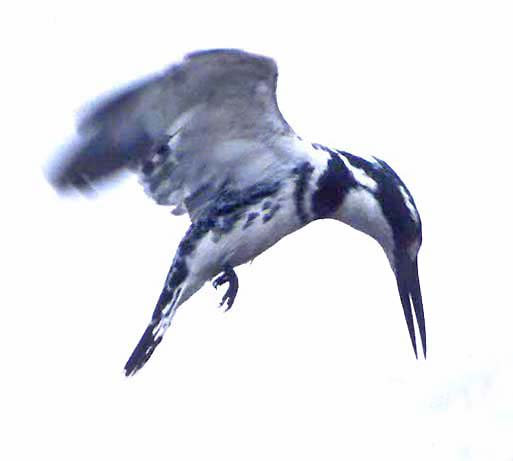 The
Cerylid Kingfishers are one of three distinct groups of kingfishers.
Known as the Water Kingfishers, these are often the conspicuous
kingfishers seen hovering over lakes, ponds, and marshes around much of
the globe. They range from high to low latitudes in Eurasia, Africa,
and the New World, but are missing from Australasia. Pied Kingfisher
is a widespread and common species in the Old World. Here (left) it is
working above a small pool in otherwise dry savanna of east Africa. It
has also been seen fishing up to 3 miles from shore on large African
lakes, and may be considered the most advanced of all the kingfishers
(Fry, Fry & Harris 1992). The
Cerylid Kingfishers are one of three distinct groups of kingfishers.
Known as the Water Kingfishers, these are often the conspicuous
kingfishers seen hovering over lakes, ponds, and marshes around much of
the globe. They range from high to low latitudes in Eurasia, Africa,
and the New World, but are missing from Australasia. Pied Kingfisher
is a widespread and common species in the Old World. Here (left) it is
working above a small pool in otherwise dry savanna of east Africa. It
has also been seen fishing up to 3 miles from shore on large African
lakes, and may be considered the most advanced of all the kingfishers
(Fry, Fry & Harris 1992).
Kingfishers have
traditionally been placed in a single family, but there are three
distinct lineages well-supported by a range of molecular, anatomical,
and molt evidence (e.g., Moyle 2006). Although most authorities still
considered them one family, it is good to learn the three major groups.
|
|
The largest kingfisher in the world is Giant Kingfisher
(above) of sub-Saharan Africa. Although we often think of these type of
kingfishers when we think of the family, there are only 9 species of
Cerylid kingfishers and thus they comprise only 10% of the world's
kingfisher, the rest of which are in other subfamilies.
|
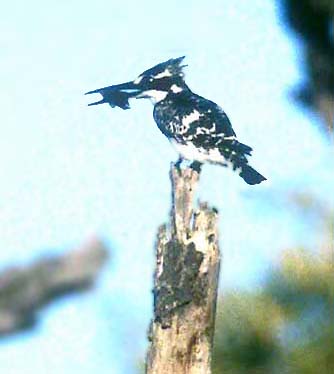 The
water kingfishers are the classic "king fishers" — they dive for fish
in ponds and rivers, and are often found perched near water. This group
of familiar kingfishers is the only one to have reached the New World;
the other two families are strictly Old World birds. There are just six
kingfishers in the New World: Belted (below), Ringed Megaceryle torquata, Amazon Chloroceryle amazona, Green C. americana, Green-and-rufous C. inda, and American Pygmy Kingfisher C. aenea. The
water kingfishers are the classic "king fishers" — they dive for fish
in ponds and rivers, and are often found perched near water. This group
of familiar kingfishers is the only one to have reached the New World;
the other two families are strictly Old World birds. There are just six
kingfishers in the New World: Belted (below), Ringed Megaceryle torquata, Amazon Chloroceryle amazona, Green C. americana, Green-and-rufous C. inda, and American Pygmy Kingfisher C. aenea.
I
have a friend who studied the five Neotropical kingfishers for his PhD
thesis. Naming no names, James, I summarize his conclusions this way:
"big kingfishers eat big fish, little kingfishers eat little fish."
This Pied Kingfisher (right) has pretty good size fish, it seems to me. In contrast, the Belted Kingfisher (series below) has a very tiny fish.
May I now have my PhD, please, having shown the contrary? |
|
|
The
five New World cerylid kingfishers are sexually dimorphic. On the
widespread Belted Kingfisher the female has a rufous band below the
blue band shown in both sexes. My series (above) is of a male. The male
Green Kingfisher (right) lacks the female's rufous breastband (left). |
|
|
 Most of the Cerylid Kingfishers are territorial loners. Crested Kingfisher
(left), of eastern Asia, generally hunts solitarily along stretches of
wild rivers running down out of the Himalayas. They spend much of their
time perched on a rock or branch over the river (or here, at the edge
of a dam), and dive obliquely for a fish. They do not dive from
hovering flight, as do many others of this family. Crested is the most
cold-hardy of all kingfishers and tolerates wintry conditions at high
elevations as long as the streams remain unfrozen (Fry, Fry &
Harris 1992). Most of the Cerylid Kingfishers are territorial loners. Crested Kingfisher
(left), of eastern Asia, generally hunts solitarily along stretches of
wild rivers running down out of the Himalayas. They spend much of their
time perched on a rock or branch over the river (or here, at the edge
of a dam), and dive obliquely for a fish. They do not dive from
hovering flight, as do many others of this family. Crested is the most
cold-hardy of all kingfishers and tolerates wintry conditions at high
elevations as long as the streams remain unfrozen (Fry, Fry &
Harris 1992).
All Water Kingfishers breed by
excavating tunnels into an earthen bank. Both parents are involved in
digging the burrow, incubating the eggs, and then feeding the young.
Birds tend to be very shy around nest sites. Indeed, despite how
conspicuous these kingfishers may appear to be, they are often
difficult to approach closely. |
Photos: The top Pied Kingfisher Ceryle rudis
was foraging over the Tarangire River in Tarangire Nat'l Park,
Tanzania, in Aug 2002; my other Pied Kingfisher shot (the one with the
fish) was from a hide in Kruger Nat'l Park, South Africa, in July 1996.
The Giant Kingfisher Megaceryle maxima was in the Okavango Delta, Botswana, in July 2005. The fish-tossing Belted Kingfisher Megaceryle alcyon was in Monterey Co., California, on 10 Jan 2004. The female Green Kingfisher Chloroceryle americana was in the Brazilian Pantanal in Aug 1999; the male was on the Osa Peninsula, Costa Rica, on 27 Dec 2007. The Crested Kingfisher Megaceryle lugubris was at Ramnagar, India, on 13 Mar 2001. All photos © Don Roberson; all right reserved.
Bibliographic note:
Family book: 
Fry, C. Hilary, Kathie Fry, and Alan Harris. 1992. Kingfishers, Bee-eaters & Rollers. Princeton Univ. Press, Princeton, N.J.
Hilary Fry is well-known as a co-author of the fabulous Birds of Africa
handbook series. He has also done a lot of research on bee-eaters and,
to a lesser extent, kingfishers. His earlier family book on Bee-eaters
(1984) in the Poyser series was well received. This volume, written a
dozen years later, is expanded to cover the kingfishers and rollers,
but Fry's forte remains the bee-eaters. I found the bee-eater text much
better than the kingfisher text. On the other hand, Alan Harris — the
artist for this 1992 book — does a fine job with this colorful family,
and thus this is a very attractive book. Leafing through the plates is
a great treat [like all the family books in these series, the plates
are grouped together in the front, with the text following].
Fry's species-level taxonomy is rather conservative, especially these
days. He includes only 87 species of kingfishers while Woodall (2001)
has 92 species. I think the latter is nearer the mark given current
trends. Fry, Fry & Harris follow the Sibley & Ahlquist (1990)
taxonomy at the family level, and thus discuss three separate families
of kingfishers [but their Dacelonidae became the Halcyonidae by Woodall
(2001) on priority grounds].
Perhaps the most annoying part of this book to me is the repeated
statement "nothing is known" about this or that species. Consider the
White-rumped Kingfisher Halcyon fulgida
of Lombok, Sumbawa, and Flores in the Lesser Sundas. This book says
"almost nothing is on record" about the species, which is "barely
known" but "must be unmistakable." Perhaps that was a fair statement in
1984, but by 1992 surely quite a bit was "known." I believe Ben King
had been running Lesser Sunda tours for a decade and routinely found
this species. According to Woodall (2001) it is considered "widespread,
and fairly common" on at least Lombok and Flores. It was not that the
species was not "known" by 1992 — it was that much new information had
not yet been published. Had the authors or publisher had the text
reviewed by some knowledgeable birders, they could have added a lot.
But, like many academic efforts, the unpublished knowledge held by
birders was overlooked in favor of a simple literature search. Thus
this 1992 book essentially recites a 1960s level of knowledge. Nothing
was "dug out" about the little-known species.
The net effect is that the African species that the Frys know well are
nicely covered, but Asian and Australasian species receive
comparatively cursory review. So this is a pretty book but not a great
family resource. Today, with Woodall (2001) available, that HBW volume
is the preferred text. Plus it has spectacular photos and exceptional
artwork!
There
is another major family book — two volumes, in fact — by Forshaw &
Cooper (1983-1985). These coffee table tomes were priced in the
thousand of dollars and may have made money for the author and artist,
but are unavailable to the rest of us. I've never even seen one. Unlike
their earlier work with parrots, a cheap, popularized single-volume
version has not appeared.
Literature cited:
Christidis, L, and W.E. Boles. 2008. Systematics and taxonomy of Australian Birds. CSIRO Publ, Sydney.
Dickinson,
E., ed. 2003. The Howard & Moore Complete Checklist of the Birds of
the World. 3d ed. Princeton Univ. Press, Princeton, N.J.
Forshaw, J.M., and W.T. Cooper. 1983-1985. Kingfishers and Related Birds. 2 vols (Kingfishers). Lansdowne Editions, Sydney.
Fry, C.H., K. Fry, and A. Harris. 1992. Kingfishers, Bee-eaters, and Rollers. Princeton Univ. Press, Princeton, N.J.
Moyle,
R.G. 2006. A molecular phylogeny of kingfishers (Aves: Alcedinidae)
with insights into early biogeographic history. Auk 123: 487-499.
Sibley, C.G., and J.E. Ahlquist. 1990. Phylogeny and Classification of
Birds: A Study in Molecular Evolution. Yale Univ. Press, New Haven, CT.
Sibley, C.G., and B.L. Monroe, Jr. 1990. Distribution and Taxonomy of Birds of the World. Yale Univ. Press, New Haven, CT.
Woodall, P.F. 2001. Family Alcedinidae (Kingfishers), pp. 130-249 in del Hoyo, J., Elliott, A., & Sargatal, J., eds. Handbook of the Birds of the World, vol. 6. Lynx Edicions, Barcelona.
|
|
|


 The
Cerylid Kingfishers are one of three distinct groups of kingfishers.
Known as the Water Kingfishers, these are often the conspicuous
kingfishers seen hovering over lakes, ponds, and marshes around much of
the globe. They range from high to low latitudes in Eurasia, Africa,
and the New World, but are missing from Australasia. Pied Kingfisher
is a widespread and common species in the Old World. Here (left) it is
working above a small pool in otherwise dry savanna of east Africa. It
has also been seen fishing up to 3 miles from shore on large African
lakes, and may be considered the most advanced of all the kingfishers
(Fry, Fry & Harris 1992).
The
Cerylid Kingfishers are one of three distinct groups of kingfishers.
Known as the Water Kingfishers, these are often the conspicuous
kingfishers seen hovering over lakes, ponds, and marshes around much of
the globe. They range from high to low latitudes in Eurasia, Africa,
and the New World, but are missing from Australasia. Pied Kingfisher
is a widespread and common species in the Old World. Here (left) it is
working above a small pool in otherwise dry savanna of east Africa. It
has also been seen fishing up to 3 miles from shore on large African
lakes, and may be considered the most advanced of all the kingfishers
(Fry, Fry & Harris 1992). The
water kingfishers are the classic "king fishers" — they dive for fish
in ponds and rivers, and are often found perched near water. This group
of familiar kingfishers is the only one to have reached the New World;
the other two families are strictly Old World birds. There are just six
kingfishers in the New World: Belted (below), Ringed Megaceryle torquata, Amazon Chloroceryle amazona, Green C. americana, Green-and-rufous C. inda, and American Pygmy Kingfisher C. aenea.
The
water kingfishers are the classic "king fishers" — they dive for fish
in ponds and rivers, and are often found perched near water. This group
of familiar kingfishers is the only one to have reached the New World;
the other two families are strictly Old World birds. There are just six
kingfishers in the New World: Belted (below), Ringed Megaceryle torquata, Amazon Chloroceryle amazona, Green C. americana, Green-and-rufous C. inda, and American Pygmy Kingfisher C. aenea.
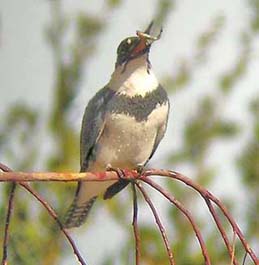
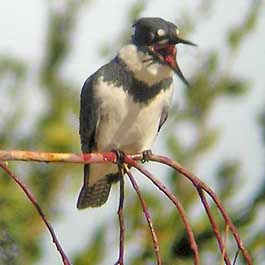

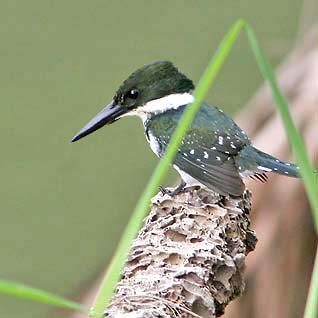
 Most of the Cerylid Kingfishers are territorial loners. Crested Kingfisher
(left), of eastern Asia, generally hunts solitarily along stretches of
wild rivers running down out of the Himalayas. They spend much of their
time perched on a rock or branch over the river (or here, at the edge
of a dam), and dive obliquely for a fish. They do not dive from
hovering flight, as do many others of this family. Crested is the most
cold-hardy of all kingfishers and tolerates wintry conditions at high
elevations as long as the streams remain unfrozen (Fry, Fry &
Harris 1992).
Most of the Cerylid Kingfishers are territorial loners. Crested Kingfisher
(left), of eastern Asia, generally hunts solitarily along stretches of
wild rivers running down out of the Himalayas. They spend much of their
time perched on a rock or branch over the river (or here, at the edge
of a dam), and dive obliquely for a fish. They do not dive from
hovering flight, as do many others of this family. Crested is the most
cold-hardy of all kingfishers and tolerates wintry conditions at high
elevations as long as the streams remain unfrozen (Fry, Fry &
Harris 1992).